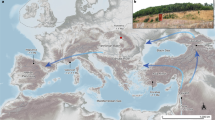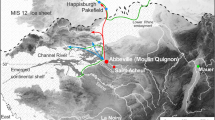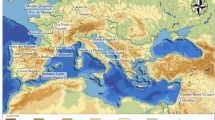Abstract
Previous excavations at Mata Menge and Boa Lesa in the Soa Basin of Flores, Indonesia, recovered stone artefacts in association with fossilized remains of the large-bodied Stegodon florensis florensis1,2,3,4,5,6,7,8,9. Zircon fission-track ages from these sites indicated that hominins had colonized the island by 0.88 ± 0.07 million years (Myr) ago6. Here we describe the contents, context and age of Wolo Sege, a recently discovered archaeological site in the Soa Basin that has in situ stone artefacts and that lies stratigraphically below Mata Menge and immediately above the basement breccias of the basin. We show using 40Ar/39Ar dating that an ignimbrite overlying the artefact layers at Wolo Sege was erupted 1.02 ± 0.02 Myr ago, providing a new minimum age for hominins on Flores. This predates the disappearance from the Soa Basin of ‘pygmy’ Stegodon sondaari and Geochelone spp. (giant tortoise), as evident at the nearby site of Tangi Talo, which has been dated to 0.90 ± 0.07 Myr ago10. It now seems that this extirpation or possible extinction event and the associated faunal turnover were the result of natural processes rather than the arrival of hominins9. It also appears that the volcanic and fluvio-lacustrine deposits infilling the Soa Basin may not be old enough to register the initial arrival of hominins on the island.
This is a preview of subscription content, access via your institution
Access options
Subscribe to this journal
Receive 51 print issues and online access
$199.00 per year
only $3.90 per issue
Buy this article
- Purchase on Springer Link
- Instant access to full article PDF
Prices may be subject to local taxes which are calculated during checkout





Similar content being viewed by others
References
van den Bergh, G. D. The Late Neogene Elephantoid-Bearing Faunas of Indonesia and their Palaeozoogeographic Implications. A Study of the Terrestrial Faunal Succession of Sulawesi, Flores and Java, including Evidence for Early Hominid Dispersal East of Wallace’s Line. (Scripta Geologica 117, Nationaal Natuurhistorisch Museum, 1997)
van den Bergh, G. D. et al. The youngest Stegodon remains in Southeast Asia from the Late Pleistocene archaeological site Liang Bua, Flores, Indonesia. Quat. Int 182, 16–48 (2008)
van den Bergh, G. D. et al. in Pleistocene Geology, Palaeontology and Archaeology of the Soa Basin, Central Flores, Indonesia (eds Aziz, F., Morwood, M. J. & van den Bergh, G. D.) 59–94 (Spec. Publ. 36, Geological Survey Institute, 2009)
Morwood, M. J., O’Sullivan, P. B., Aziz, F. & Raza, A. Fission-track ages of stone tools and fossils on the east Indonesian island of Flores. Nature 392, 173–176 (1998)
Morwood, M. J. et al. Archaeological and palaeontological research in central Flores, east Indonesia: results of fieldwork 1997-98. Antiquity 73, 273–286 (1999)
O’Sullivan, P. B. et al. Archaeological implications of the geology and chronology of the Soa Basin, Flores, Indonesia. Geology 29, 607–610 (2001)
Maringer, J. & Verhoeven Die Steinartefakte aus der Stegodon-Fossilschicht von Mengeruda auf Flores, Indonesien. Anthropos 65, 229–247 (1970)
Maringer, J. & Verhoeven Die Oberflächenfunde aus dem Fossilgebiet von Mengeruda und Olabula auf Flores, Indonesien. Anthropos 65, 530–546 (1970)
Sondaar, P. Y. et al. Middle Pleistocene faunal turn-over and colonisation of Flores (Indonesia) by Homo erectus . C.R. Acad. Sci. 319, 1255–1262 (1994)
Aziz, F. et al. in Pleistocene Geology, Palaeontology and Archaeology of the Soa Basin, Central Flores, Indonesia (eds Aziz, F., Morwood, M. J. & van den Bergh, G. D.) 41–58 (Spec. Publ. 36, Geological Survey Institute, 2009)
Suminto et al. in Pleistocene Geology, Palaeontology and Archaeology of the Soa Basin, Central Flores, Indonesia (eds Aziz, F., Morwood, M. J. & van den Bergh, G. D.) 19–40 (Spec. Publ. 36, Geological Survey Institute, 2009)
Muraoka, H. et al. Tectonic, volcanic and stratigraphic geology of the Bajawa geothermal field, central Flores, Indonesia. Bull. Geol. Survey Jpn 53, 109–138 (2002)
Brumm, A. et al. Early stone technology on Flores and its implications for Homo floresiensis . Nature 441, 624–628 (2006)
Moore, M. W. & Brumm, A. Stone artifacts and hominins in island Southeast Asia: new insights from Flores, eastern Indonesia. J. Hum. Evol. 52, 85–102 (2007)
Moore, M. W. & Brumm, A. in Interdisciplinary Approaches to the Oldowan (eds Hovers, E. & Braun, D. R.) 61–69 (Springer, 2009)
Brumm, A. et al. Stone technology at the Middle Pleistocene site of Mata Menge, Flores, Indonesia. J. Arch. Sci. 37, 451–473 (2010)
Shea, J. J. Artifact abrasion, fluvial processes, and “living floors” from the Early Paleolithic site of ’Ubeidiya (Jordan Valley, Israel). Geoarchaeology 14, 191–207 (1999)
van den Bergh, G. D. et al. The Late Quaternary palaeogeography of mammal evolution in the Indonesian Archipelago. Palaeogeogr. Palaeoclimatol. Palaeoecol. 171, 385–408 (2001)
Morwood, M. J. & Aziz, F. in Pleistocene Geology, Palaeontology and Archaeology of the Soa Basin, Central Flores, Indonesia (eds Aziz, F., Morwood, M. J. & van den Bergh, G. D.) 139–146 (Spec. Publ. 36, Geological Survey Institute, 2009)
Brown, P. et al. A new small-bodied hominin from the Late Pleistocene of Flores, Indonesia. Nature 431, 1055–1061 (2004)
Morwood, M. J. et al. Further evidence for small-bodied hominins from the Late Pleistocene of Flores, Indonesia. Nature 437, 1012–1017 (2005)
Morwood, M. J. et al. Archaeology and age of a new hominin from Flores in eastern Indonesia. Nature 431, 1087–1091 (2004)
Argue, D. et al. Homo floresiensis: microcephalic, pygmoid, Australopithecus, or Homo? J. Hum. Evol. 51, 360–374 (2006)
Jungers, W. L. et al. The foot of Homo floresiensis . Nature 459, 81–84 (2009)
Dennell, R. & Roebroeks, W. An Asian perspective on early human dispersal from Africa. Nature 438, 1099–1104 (2005)
Dennell, R. W. The Palaeolithic Settlement of Asia (Cambridge Univ. Press, 2009)
Tocheri, M. W. et al. The primitive wrist of Homo floresiensis and its implications for hominin evolution. Science 317, 1743–1745 (2007)
Morwood, M. J. & Jungers, W. L. Conclusions: implications of the Liang Bua excavations for hominin evolution and biogeography. J. Hum. Evol. 57, 640–648 (2009)
Renne, P. R. et al. Intercalibration of standards, absolute ages and uncertainties in 40Ar/39Ar dating. Chem. Geol. 145, 117–152 (1998)
Renne, P. R., Knight, K. B., Nomade, S., Leung, K.-N. & Lou, T.-P. Application of deuteron-deuteron (D-D) fusion neutrons to 40Ar/39Ar geochronology. Appl. Radiat. Isot. 62, 25–32 (2005)
Acknowledgements
The 2005 excavations in the Soa Basin were funded by a Discovery Project grant from the Australian Research Council (ARC) to M.J.M. The Soa Basin research was authorized by D. Sukarna and D. Kosasih. The Ngadha excavation team was led by K. Podhi and consisted of H. Bele, P. Carpus, J. Dadi, A. Djo, S. Gholo, M. Lalu, M. Lebe and M. Rani. Other participants included Dadang and Ngaliman. R. G. Roberts, K. Westaway and D. Phillips are acknowledged for their initial contributions to dating the site; R. G. Roberts, in particular, is thanked for his assistance and support. G. Barker and N. Ashton are also acknowledged, and M. W. Moore is thanked for preparing images of the artefacts. The 2005 fieldwork of A.B. at Wolo Sege was supported by an Australian National University PhD co-funded stipend scholarship, and follow-up research was funded by an ARC Discovery postdoctoral research fellowship based at the University of Wollongong and a postdoctoral research fellowship at the McDonald Institute for Archaeological Research, University of Cambridge. A grant from the D. M. McDonald Grants and Awards Fund is also acknowledged. The Quaternary Dating Laboratory at Roskilde University is funded by the Villum Kann Rasmussen Foundation. G.M.J. is supported by a PhD stipend co-funded by the Villum Kann Rasmussen Foundation, Roskilde University and The Danish Agency for Science, Technology and Innovation. We thank O. Stecher for technical assistance and J. Saxton and A. Deino for discussions on multi-collector noble-gas mass spectrometry.
Author Contributions A.B. located and excavated the Wolo Sege site and analysed the stone artefacts. G.D.v.d.B. mapped, described and interpreted the stratigraphic units and prepared Fig. 5 (with M.J.M.), and I.K. supervised the excavation. G.M.J. identified and sampled Wolo Sege ash layers suitable for dating and carried out the mineral separation. M.S. carried out the 40Ar/39Ar multi-collector dating experiments. M.J.M. and F.A. are the Chief Investigator and the Australian and Indonesian Institutional Counterpart in this ARC project, respectively, and provided support and advice for the Wolo Sege excavation.
Author information
Authors and Affiliations
Corresponding author
Ethics declarations
Competing interests
The authors declare no competing financial interests.
Additional information
Any enquiries for additional information and data relating to the Quaternary Dating Laboratory 40Ar/39Ar ages should be addressed to M.S. (storey@ruc.dk).
Supplementary information
Supplementary Figures
This file contains Supplementary Figures 1-4 with legends: 1) photograph of the Wolo Sege excavation site (September 2005) and the dated volcanic units and ignimbrite; 2) descriptive statistics of the Wolo Sege flake assemblage; 3) age probability plots; and 4) maps of positions of dating samples and standards. (PDF 2519 kb)
Supplementary Table 1
This file contains Supplementary Table 1 in two parts, Table 1a gives the hornblende fusion results (relative Ar isotopic abundances and derived ages) for the 40Ar/39Ar dating. Table 1b gives monitor ACs-2 relative isotropic abundances and calculated J value. (XLS 137 kb)
Rights and permissions
About this article
Cite this article
Brumm, A., Jensen, G., van den Bergh, G. et al. Hominins on Flores, Indonesia, by one million years ago. Nature 464, 748–752 (2010). https://doi.org/10.1038/nature08844
Received:
Accepted:
Published:
Issue Date:
DOI: https://doi.org/10.1038/nature08844
This article is cited by
-
Characterising the stone artefact raw materials at Liang Bua, Indonesia
Journal of Paleolithic Archaeology (2022)
-
Pleistocene Water Crossings and Adaptive Flexibility Within the Homo Genus
Journal of Archaeological Research (2021)
-
Semiotics and the Origin of Language in the Lower Palaeolithic
Journal of Archaeological Method and Theory (2021)
-
Last appearance of Homo erectus at Ngandong, Java, 117,000–108,000 years ago
Nature (2020)
-
Earliest known hominin activity in the Philippines by 709 thousand years ago
Nature (2018)
Comments
By submitting a comment you agree to abide by our Terms and Community Guidelines. If you find something abusive or that does not comply with our terms or guidelines please flag it as inappropriate.



